Abstract
In this paper, we present formulae for evaluating differential quantities at vertices of triangular meshes that may approximate potential piecewise smooth surfaces with discontinuous normals or discontinuous curvatures at the joint lines. We also define the C 1 and C 2 discontinuity measures for surface meshes using changing rates of one-sided curvatures or changing rates of curvatures across mesh edges. The curvatures are computed discretely as of local interpolating surfaces that lie within a tolerance to the mesh. Together with proper estimation of local shape parameters, the obtained discontinuity measures own properties like sensitivity to salient joint lines and being scale invariant. A simple algorithm is finally developed for detection of C 1 or C 2 discontinuity joint lines on triangular meshes with even highly non-uniform triangulations. Several examples are provided to demonstrate the effectiveness of the proposed method.














Similar content being viewed by others
References
Agathos A, Pratikakis I, Perantonis S, Sapidis N, Azariadis P (2007) 3D mesh segmentation methodologies for cad applications. Comput Aided Des Appl 4(6):827–842
Angelo LD, Stefano PD (2010) C 1 continuities detection in triangular meshes. Comput Aided Des 42(9):828–839
Baker TJ (2004) Identification and preservation of surface features. In: Proceedings of the 13th international meshing roundtable, pp 299–310
Canny J (1986) A computational approach to edge detection. IEEE Trans Pattern Anal Mach Intell 8(6):679–698
Demarsin K, Vanderstraeten D, Volodine T, Roose D (2007) Detection of closed sharp edges in point clouds using normal estimation and graph theory. Comput Aided Des 39(4):276–283
Elber G (1996) Error bounded piecewise linear approximation of freeform surfaces. Comput Aided Des 28(1):51–57
Hubeli A, Meyer K, Gross MH (2000) Mesh edge detection. In: Workshop Lake Tahoe, Lake Tahoe City, California, USA, October 15–17
Jiao X, Bayyana NR (2008) Identification of c1 and c2 discontinuities for surface meshes in CAD. Computer Aided Des 40(2):160–175
Jiao X, Heath M (2002) Feature detection for surface meshes. In: Proceedings of 8th international conference on numerical grid generation in computational field simulations, pp 705–714
Kim HS, Choi HK, Lee KH (2009) Feature detection of triangular meshes based on tensor voting theory. Comput Aided Des 41(1):47–58
Kimia BB, Frankel I, Popescu AM (2003) Euler spiral for shape completion. Int J Comput Vis 54(1–3):159–182
Lavoué G, Dupont F, Baskurt A (2005) A new cad mesh segmentation method, based on curvature tensor analysis. Computer-Aided Design 37(10):975–987
Max N (1999) Weights for computing vertex normals from facet normals. J Graphics Tools 4(2):1–6
Meek DS, Walton DJ (2000) On surface normal and gaussian curvature approximations given data sampled from a smooth surface. Comput Aided Geom Des 17(6):521–543
Meyer M, Desbrun M, Schröder P, Barr AH (2003) Discrete differential-geometry operators for triangulated 2-manifolds. In: Visualization and mathematics III, pp 35–57
Page DL, Koschan A, Sun Y, Paik JK, Abidi MA (2001) Robust crease detection and curvature estimation of piecewise smooth surfaces from triangle mesh approximations using normal voting. In: CVPR, pp 162–167
Shimizu T, Date H, Kanai S, Kishinami T (2005) A new bilateral mesh smoothing method by recognizing features. In: Proceedings of the ninth international conference on computer aided design and computer graphics, pp 281–286
Sunil VB, Pande SS (2008) Automatic recognition of features from freeform surface cad models. Comput Aided Des 40(4):502–517
Tang CK, Medioni GG (1999) Robust estimation of curvature information from noisy 3D data for shape description. In: ICCV, pp 426–433
Taubin G (1995) Estimating the tensor of curvature of a surface from a polyhedral approximation. In: ICCV, pp 902–907
Thürmer G, Wüthrich C (1998) Computing vertex normals form polygonal facets. J Graphics Tools 3(1):43–46
Várady T, Facello MA, Terék Z (2007) Automatic extraction of surface structures in digital shape reconstruction. Comput Aided Des 39(5):379–388
Vidal V, Wolf C, Dupont F (2011) Robust feature line extraction on cad triangular meshes. In: Proceedings of the international conference on computer graphics theory and applications, GRAPP 2011, pp 106–112
Walton DJ, Meek DS (2009) G 1 interpolation with a single cornu spiral segment. J Comput Appl Math 223:86–96
Wang D, Hassan O, Morgan K, Weatherill N (2007) Enhanced remeshing from stl files with applications to surface grid generation. Commun Numer Methods Eng 23(3):227–239
Wang J, Yu Z (2011) Surface feature based mesh segmentation. Comput Graphics 35(3):661–667
Wang X, Liu X, Lu L, Li B, Cao J, Yin B, Shi X (2012) Automatic hole-filling of cad models with feature-preserving. Computers & Graphics 36(2):101–110
Yamakawa S, Shimada K (2010) Polygon crawling: feature edge extraction from a general polygonal surface for mesh generation. Eng Comput 26(3):249–264
Acknowledgments
We owe thanks to anonymous referees for their helpful comments on an earlier version of the paper. This work is supported by Natural Science Foundation of China Grants (60970077, 11290142), the ARC 9/09 Grant (MOE2008-T2-1-075), MOE RG 59/08 (M52110092), NRF 2007IDM-IDM002-010 of Singapore.
Author information
Authors and Affiliations
Corresponding author
Rights and permissions
About this article
Cite this article
Yang, X., Zheng, J. & Wang, D. A computational approach to joint line detection on triangular meshes. Engineering with Computers 30, 583–597 (2014). https://doi.org/10.1007/s00366-012-0303-9
Received:
Accepted:
Published:
Issue Date:
DOI: https://doi.org/10.1007/s00366-012-0303-9




